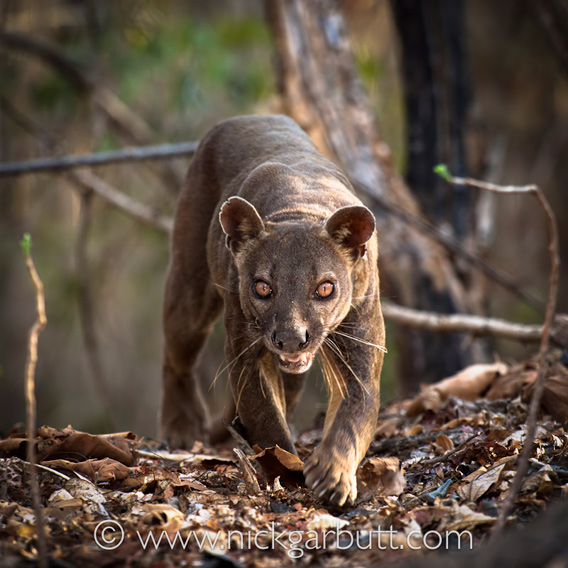
The fossa. Photo © Nick Garbutt .
An interview with Mia-Lana Lührs, a part of our Interviews with Young Scientists series.
Madagascar is a land of wonders: dancing lemurs, thumbnail-sized chameleons, the long-fingered aye-aye, great baobab trees, and the mighty fossa. Wait—what? What’s a fossa? It’s true that when people think of Madagascar rarely do they think of its top predator, the fossa—even if they are one of the few who actually recognizes the animal. While the fossa gained a little notice in the first Madagascar film by Dreamworks, its role in the film was overshadowed by the lemurs. In this case, art imitates life: in conservation and research this feline-like predator has long lived in the shadow of its prey, the lemur. Even scientists are not certain what to do with the fossa: studies have shown that it’s not quite a cat and not quite a mongoose and so the species—and its few Malagasy relatives—have been placed in their own family, the Eupleridae, of which the fossa (Cryptoprocta ferox) is the biggest. But if this is the first you’ve heard of such matters, don’t feel bad: one of the world’s only fossa-researchers, Mia-Lana Lührs also stumbled on the species.
“I found out about fossas only by coincidence. When I was working in a zoo, I became familiar with the European Endangered Species Program (EEP). Searching these programs on the web, I came to the website of Duisburg Zoo where the fossa’s EEP is managed. When I saw the pictures of the fossas on that page, I was absolutely puzzled that I had never heard of this species before, although I have always been interested in carnivores. I couldn’t even tell which family of carnivore this one might belong to,” Mia-Lana Lührs, a PhD student at the University of Göttingen in Germany, told mongabay.com. Despite such a puzzling introduction to Madagascar’s biggest predator, Lührs has become one of the world’s foremost experts on the enigmatic animal.
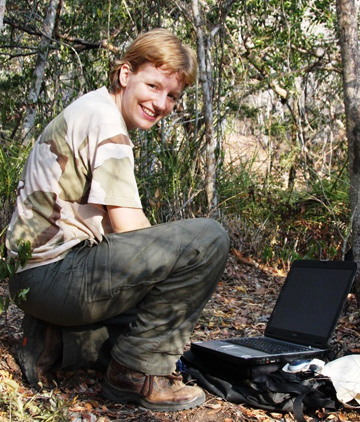 Mia-Lana Lührs is a PhD student of the department of Sociobiology/Anthropology at the University of Göttingen. Her thesis focuses on the social system of Madagascar’s largest extant carnivore, the fossa (Cryptoprocta ferox). Photo © Melanie Dammhahn. |
Lührs says that fossas may have been, in part, neglected by conservationists and researchers for so long, because of the “dominance of primatological research (i.e. lemurs) in Madagascar […] in fact, fossas are such fascinating creatures that they should be popular all around the world despite their limited distribution.”
Many characteristics make fossas wildly intriguing: adept arboreal hunting skills to take down lemurs and bizarre mating habits, including smaller females dominating the process, mating that can last hours and occur with multiple partners, and vocalizations that Lührs says “sounds like a murder is occurring.”
“What follows is, how David Attenborough put it, ‘a delicate affair’,” Lührs explains. “Females will mate multiply with many but not all males present. They can copulate up to 57 times with up to 10 different males. A single copulation can last longer than six hours and one female can mate in one such period for 40 hours in total. That is definitely something interesting to look at as a fossa’s mating activity by far exceeds mammal average.”
In her study of the fossa, Lührs has also had the thrill of watching these acrobatic carnivores hunt, including the first evidence of cooperative hunting by three fossa males.
“What followed was probably the most impressive scene I have ever seen in my life,” she says. “Three male fossas started to hunt the single sifaka. […] The whole chase went very quickly and at some point I was in the middle of it because the hunting fossas suddenly used the little wooden hut, which I used as a hide, as climbing substrate. Two males jumped right and left from me on the wooden beams of the hut, and splinters of wood, leaves and dust flew around me. […] Forty-five minutes after the very start of this hunt, the three male fossas finally managed to catch the sifaka when it became tired and made a single wrong decision.”
Lührs believes the cooperative hunting was an evolutionary behavior leftover from Madagascar’s past when giant lemurs would have provided fossas with meatier, and more difficult, prey.
“Now that giant lemurs are extinct, cooperative hunting appears useless unless it allows the participating individuals to catch a sifaka more rapidly. In the case that I have seen, it took three males 45 minutes. All three of them were totally exhausted afterwards and had to share about three kilograms of meat by three. That does not appear to me as an effective strategy,” Lührs explains.
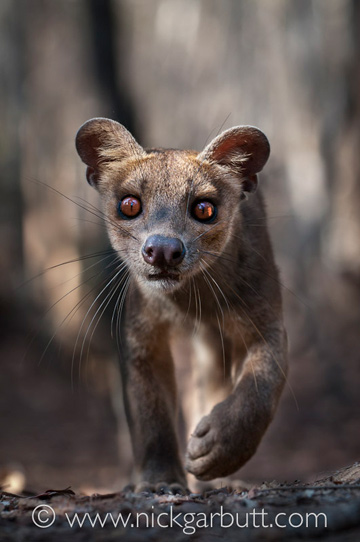 The fossa. Photo © Nick Garbutt . |
Unfortunately fossas, like much of Madagascar’s wild biodiversity, are faced with extinction. Classified as Vulnerable by the IUCN Red List, Lührs says more research is needed to know if fossas are in fact doing worse than believed. The greatest impact on fossas is habitat loss, which has led to numerous challenges for big predators requiring large spaces to hunt. In her study site, Kirindy Forest, Lührs sees what she calls a ‘crowding effect’, where fossa individuals are forced to compete for dwindling habitat.
“It is likely that we will soon see dramatic consequences of the ongoing habitat destruction, such as an increase in injuries and death due to frequent encounters of fossas with one another, high infant mortality (for the latter reason and because of food shortage), bad body condition, especially during the lean season in winter due to high competition for food, as well as all the problems of small populations such as inbreeding, sex ratio shifts and the threat of diseases. Moreover, more and more fossas seem to leave the forest in search for habitat and food,” Lührs says.
Dwindling forests have also pushed fossas into Malagasy villages. The fossas are typically looking for poultry to catch, and seen as pests they are sometimes attacked by villagers.
“Given the value of every single chicken for a poor villager, this conflict can result in killings of the respective fossas. […] Mortality of fossas in surrounding village areas seems to be a major problem,” Lührs says.
Lührs says she is pessimistic, but not hopeless regarding the long-term survival of the fossa. To save the species the first thing that is needed is more research, including “an intensive fossa survey all over Madagascar” according to Lührs. Right now conservationists simply don’t know how many fossas survive and where populations are viable.
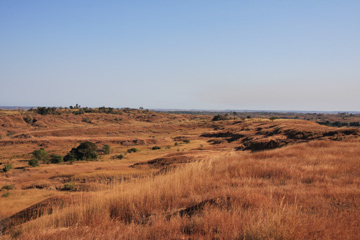 Where forest has been burnt down, savannah dominates Madagascar’s landscape. This habitat offers grazing ground for many zebus but its biodiversity is low. Very few native species manage to survive in savannah habitat, mainly generalizers, such as birds and insects. Photo © Melanie Dammhahn. |
“On the longer perspective, I see an urgent need to make local people benefit from conservation: possibly the only way to change their mind about how to deal with fossas would be to assign some economic value to a living fossa,” Lührs says. “Until now villagers do not see any economic value in a fossa, they just perceive it as a pest. But in fact, many tourists come every year to Kirindy to see exactly this species. Their money, however, rarely ends up in the villages. What we need is the awareness that the forest and its biodiversity are property of Malagasy people and that we should pay money for them to protect this forest and this species thereby creating some alternative income. And we are talking about very little money from our perspective which could make big changes from a Malagasy perspective.”
For Lührs working with the fossa, a little known species, has its many rewards, including the chance to make new discoveries and develop a conservation plan that may make all the difference between long-term survival and extinction.
“I’ve always been much more concerned about species that die out secretly without anyone ever knowing they existed at all. The fossa is certainly one of those species. For the sake of conservation of the world’s biodiversity, I would therefore like to encourage more researchers to focus on the ‘forgotten species in the background’,” she says.
In a January 2011 interview Mia-Lana Lührs discussed new discoveries about Madagascar’s biggest predator, the fossa; conservation efforts needed to save the species; the joy of working with a little-known species; and if she’d whether be a male or female fossa.
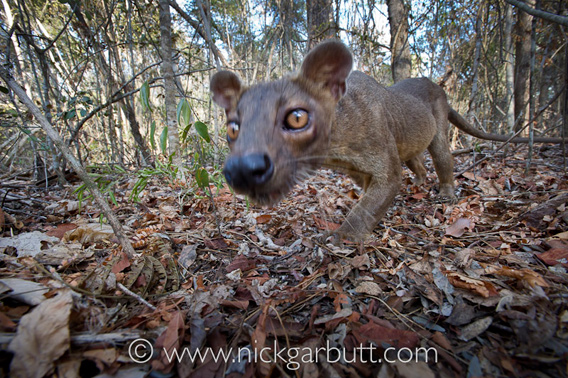
A curious fossa. Photo © Nick Garbutt .
INTERVIEW WITH MIA-LANA LÜHRS
Mongabay: What is your background? What led to your interested in wildlife?
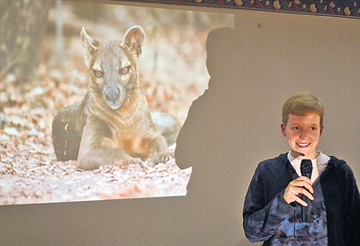 Mia-Lana Lührs sees her most important mission as informing people about the fascinating and threatened Madagascar and the fossa, as public awareness and interest represents the first step for effective conservation. She therefore regularly gives presentations to the general public, like shown here for the German Society for Nature Conservation (NABU) in Bad Münder. Photo © Neue Deister-Zeitung. |
Mia-Lana Lührs: Actually, I come from an agricultural background. I grew up on a little farm in a tiny village in northern Germany. In my childhood, I had close contact with animals and nature in general. I think I inherited my mother’s craziness for animals and my father’s interest in nature. I’ve spent my whole childhood outside in the green. I also grew up with a number of cats to which I had a special relationship. I developed a feeling for the needs of animals, which allowed me to tame even very wild cats into cuddly pets. My family and friends have always admired my effect on animals and encouraged me to apply this to my profession. These two circumstances, in combination with my very early interest in conservation of the world’s biodiversity, made me decide to become a conservationist who tries to make this world a little better. Interestingly, I still benefit a lot from my experience with cats when I work with fossas. There is a relationship between these animals and me that allows me to come very close and to see behavior, which other people might never see. I am very grateful that the animals accept my presence so easily and I enjoy every single moment we share.
Mongabay: Where did you first learn about the fossa?
Mia-Lana Lührs: I found out about fossas only by coincidence. When I was working in a zoo, I became familiar with the European Endangered Species Program (EEP). Searching these programs on the web, I came to the website of Duisburg Zoo where the fossa’s EEP is managed. When I saw the pictures of the fossas on that page, I was absolutely puzzled that I had never heard of this species before, although I have always been interested in carnivores. I couldn’t even tell which family of carnivore this one might belong to. And so I became really curious to find out more about it. I read a lot about the species, learned that it occurs only on Madagascar and became immediately fascinated by its appearance and habits. From that day on I kept the fossa somewhere in my mind as a species which would be interesting to work on.
Mongabay: Why do you think this unique animal is so little known? Why has there been so little research on it?
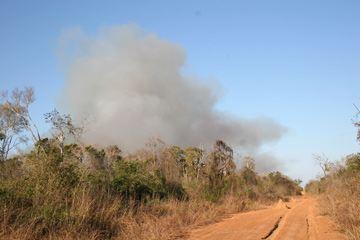 A common sight in Madagascar are columns of smoke marking myriads of fires on the island originating from destructive slash-and-burn-agriculture. While Madagascar is rich in biodiversity, its people are some of the poorest in the world. Environmental degradation, including destruction of forests, erosion, loss of biodiversity has brought further suffering. Experts have warned that the island could become the ‘next Haiti’. Photo © Melanie Dammhahn. |
Mia-Lana Lührs: In general, all solitary carnivores are very difficult to study and consequently remain little known because of their low densities and their often very enigmatic lifestyle. Many carnivores are hunted and therefore very difficult to approach. Moreover, they are often difficult to trap so that even remote tracking is very difficult. The fossa, however, is rather easy to work on, at least in Kirindy Forest, because they can easily be trapped with live-traps during the local dry season. At least in Kirindy Forest, they also occur at relatively high densities, are regularly sighted, and are less afraid of humans than other carnivores. Moreover, they have a very conspicuous mating behavior, which makes them a good model to study carnivore-mating systems. I therefore can hardly tell why they are so little known. It may be that their very restricted distribution makes them hard to detect by researchers interested in carnivore behavior. Most animal research on Madagascar focuses on lemur behavior and conservation. I started in a primatological department to come to Madagascar in order to study the fossa. This dominance of primatological research (i.e. lemurs) in Madagascar might be the reason why fossas have been neglected. In fact, fossas are such fascinating creatures that they should be popular all around the world despite their limited distribution. We are currently working together with Nick Garbutt and the BBC to change this.
Mongabay: What led you to switch from studying lemurs to studying their main predator (after humans of course)?
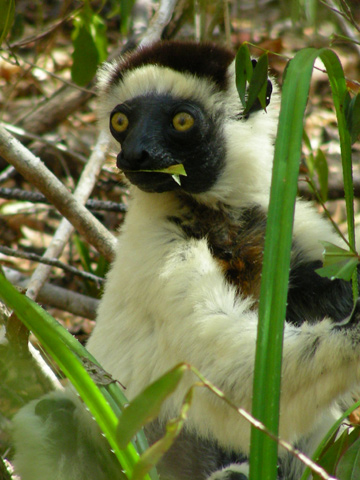 Seasonally, sifakas can make up 11% of a fossa’s diet. Yet, the fossa as a predator is not the lemur’s enemy but a guard of the forest’s health and biodiversity. If their only predator, the fossa, goes extinct, sifakas and many other lemurs and animals will face dramatic changes in forest structure and animal community. Some species will outcompete others, thereby leading to secondary species extinction. Illnesses will spread easily in high density populations leading to serious threats for those species. Wouldn’t we rather prefer the fossa to remove the weakest ones over such a scenario? Photo © Anna V. Schnöll. |
Mia-Lana Lührs: When I came to our department I actually aimed already to study fossas. After I had found out that fossas are present at the DPZ field station, I asked the head of the department, Professor Dr. Peter Kappeler, whether I could study fossas in Kirindy for my diploma thesis. By that time, the last fossa study had been conducted 10 years ago and was known to be a very difficult venture. He found a project on fossas too risky for a rather short diploma thesis because he couldn’t give me any assurance that we could manage to trap, track, or observe fossas during my three months stay in the field. He therefore recommended that I switch to lemurs, to develop a secure little project for my diploma thesis and to keep the fossas in mind for a possible PhD project.
I think, by that time, he was hoping that I would forget about the crazy fossa idea. But, of course, after I had met my very first fossa in the wild, it was love on the first sight and I was dead set on working with this species whatever it might cost me. So I went back to Peter after my diploma thesis and asked him again for a PhD project on fossas. After a short (and unsuccessful) attempt to change my mind, he gave me the possibility to conduct a preliminary field study on fossas to find out about the practicability of such a project. This study, which I conducted in 2007 with funding from Duisburg zoo, was so successful that I came back with lots of interesting data, which in the end convinced Peter to let me do this project.
Mongabay: Having achieved notable successes in uncovering new information about the fossa, what recommendations would you give students interested in studying little-known species?
Mia-Lana Lührs: First, I would encourage everyone to work with little-known species. I’ve always wanted to do exactly this because I’ve known that the well-known species will receive a lot of attention, which makes them less likely to go extinct. I’ve always been much more concerned about species that die out secretly without anyone ever knowing they existed at all. The fossa is certainly one of those species. For the sake of conservation of the world’s biodiversity, I would therefore like to encourage more researchers to focus on the “forgotten species in the background”. It is certainly more difficult to achieve funding for such projects, since investors never know about the practicability. In my case, a preliminary study was very helpful to get funding later on. I would therefore recommend such a first attempt to test and to optimize different methods to investigate the respective species. Once you have received the first data, find a scientifically relevant question your species may serve as a model for. This is actually the wrong direction of developing a scientific project—you should rather first have a question and then find a model. But in fact, working with little known species implies this wrong direction. For preliminary studies, you need a high motivation, lots of patience and a high tolerance of frustration. You might even need private money at the start, but there are also several institutions supporting preliminary studies on endangered species (e.g. the Mohamed bin Zayed Species Conservation Fund, specific programs of various zoos, etc.) that are worth applying for. I started my thesis with help of a specific Fossa Fund of Duisburg Zoo, for example.
And don’t forget that studying little-known species pays off! There is more to find out the less you know about a species and you can initiate an important step for the conservation of such a species!
NEW DISCOVERIES ABOUT THE FOSSA
Mongabay: Could you tell us about your first encounter with a fossa?
Mia-Lana Lührs: Of course. My very first fossa I met on the toilet:-). I had just started with my project on mouse lemurs in Kirindy Forest. One evening, after sunset, I went to our camp toilet (basically a hole in the ground) when suddenly something huge crashed through the forest heading to the toilet. To my surprise, it wasn’t an elephant but rather a small fossa. I froze in the same position because I was so fascinated that I had finally found it. I was wondering what it might do if I just didn’t move. Being very well habituated to humans, it simply did not seem to care at all about my presence. It was much more interested in the toilet. So I stayed and observed it exploring the hole and rubbing around it. After a while, it developed more interest in me. It looked at me and then sniffed at my trousers. It found the smell of my trousers very interesting (probably containing elements of mouse lemur smell) and suddenly bit into it. This made me a little more careful and I jumped a few meters away. From that position I observed the fossa a little longer until it disappeared again into the forest. On my way back to the tent, I wondered why my skin burned a little. Lifting my trousers, I found a drop of blood running down my leg. The fossa had not only bitten two perfectly round holes into my trousers but had also slightly injured my skin without me feeling it. This impressed me even more, I have to say. Their teeth are so sharp that you don’t feel the cut. I was absolutely excited after this very close encounter, and the trousers with the fossa bite have remained my favorite trousers. Yet, I wouldn’t recommend anyone imitate that.
Mongabay: Why use GPS over radio-telemetry in tracking the fossa?
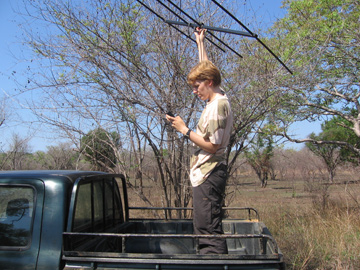 Here Lührs attempts radio-tracking, but radio-tracking turned out to be a non-feasible technique to track fossa movements, mainly due to its limited range, the far range of fossas and the inaccessibility of some forest areas. The use of GPS technique to record movements of far-ranging animals made long-range continuous tracking of several individuals simultaneously possible without any need to follow and thereby disturb the animals. Using this technique, fossas turned out to range much farther than previously thought and even visits of villages can be documented. Photo © Mia-Lana Lührs. |
Mia-Lana Lührs: Fossas turned out to be extremely far-ranging. They are certainly not the farthest ranging carnivores but as a forest-dwelling species, ranging areas of up to 100 km², it is impossible to locate them by radio-tracking techniques. Radio-tracking of far-ranging species requires either a plane or a car to locate them. The use of a plane is not a desirable option and the use of cars implies a network of roads, which cover the whole area used by the animals. This is neither the case in Kirindy nor is it desirable to establish new roads because of the forest fragmentation effect. We therefore concluded that GPS-tracking is the only feasible technique. The GPS devices record locations of the animals automatically and store all information until we either download it via remote control or we re-trap the animal to take off the collar. The error in every GPS position is much smaller than in any position determined by long-distance radio-tracking. We don’t need to approach the animals and thereby we never chase them. The animals can move in their natural ranges and the satellites will find them wherever they are located in the forest. GPS-tracking is therefore the best method to use for far-ranging animals of appropriate size.
Another advantage of GPS-tracking is that we can track several individuals simultaneously. This is very helpful for my study in particular, as I am interested in the species’ social organization. Using GPS, I can determine the degree of sociality within and between the sexes.
Mongabay: What did your tracking tell you about fossa home ranges?
Mia-Lana Lührs: Using the GPS-technique, we found fossa home ranges to be at least twice the size of what was estimated in the first study by Dr. Clare Hawkins using radio-tracking. The restriction of radio-tracking by car to the roads might explain this difference because Dr. Hawkins had no possibility to locate the animals outside the local road system, which we have today thanks to the GPS technique. We found first indications that females are territorial and show little overlap with other females, whereas males have three times larger ranges than females which are too big for them to actively defend. Males therefore overlap with other males and rather avoid each other temporally within this overlap area. The size of male ranges (up to 100 km²) shocked us, I have to say, because a single male’s range can cover a substantial part of the remaining surface of intact forest in Kirindy. This implies, first, that males might range farther if there was more forest available and second, that Kirindy Forest is unlikely to retain a fossa population of sufficient size. The more individuals I track the more evident the “crowding effect” of fossas in Kirindy becomes. I sometimes wonder how they manage to avoid each other if so many fossas have to share so little space. It is likely that we will soon see dramatic consequences of the ongoing habitat destruction, such as an increase in injuries and death due to frequent encounters of fossas with one another, high infant mortality (for the latter reason and because of food shortage), bad body condition, especially during the lean season in winter due to high competition for food, as well as all the problems of small populations such as inbreeding, sex ratio shifts and the threat of diseases. Moreover, more and more fossas seem to leave the forest in search for habitat and food, thereby ending up in villages surrounding the forest. This again causes typical human-carnivore conflict and thereby new causes of mortality.
Mongabay: What makes fossa mating behavior so unique?
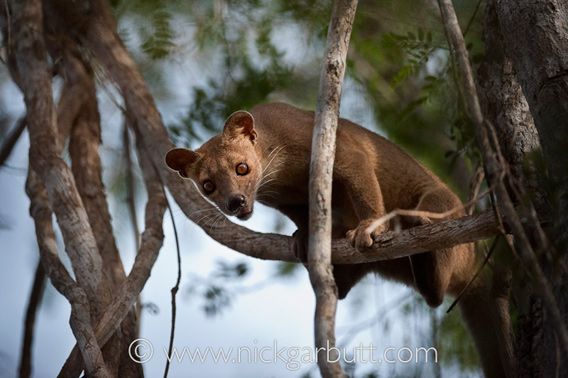
The agile arboreal fossa. Photo © Nick Garbutt .
Mia-Lana Lührs: Well, there are several reasons why the fossa’s mating behavior can be considered unique. The most proximate one is clearly the lek-like spatial organization of the spectacle. During the mating season (November), female fossas coming into oestrus visit specific trees to mate on. These trees are located close to water sources (which are scarce during this season) and they appear quite high in comparison to the surrounding canopy. Apart from those details they don’t have anything obvious in common and represent very different tree species (including even the majestic baobabs which are difficult climb).
The female stays with “her” tree for about a week. At the beginning of its activity, the female typically calls loudly, presumably to attract males. Over time, up to 18 different males can visit the tree. Since females use the same trees over several years, males learn where to find them and patrol the trees they have learnt to know before the onset of the mating season. During the last half of the female’s activity, the actual mating takes place. These matings are the second reason why the fossa’s mating system is so unique. What follows is, how David Attenborough put it, “a delicate affair”. Females will mate multiply with many but not all males present. They can copulate up to 57 times with up to 10 different males. A single copulation can last longer than six hours and one female can mate in one such period for 40 hours in total. That is definitely something interesting to look at as a fossa’s mating activity by far exceeds mammal average. Males have very long penises, which are equipped with spines. These spines might allow them to maintain the copulatory lock ,which is another characteristic of fossa copulations.
For those who have ever seen fossas mating, another reason why they will never forget it is the noise. Fossa mating is highly vocal although the species itself is not (at least outside the mating season). If you hear it without knowing what it is, you will be very afraid and certainly leave the forest as fast as you can, as it sounds like a murder is occurring. The loud and rhythmic vocalizations of the female can be heard over long distances and remind one very much of copulation calls of other species (including humans;-). In fact, this is a common misunderstanding. The rhythmic vocalizations produced by the females are typical of aggressive interactions between male and female and independent of any mating activity.
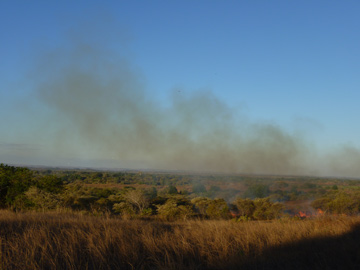 Forest burns in Madagascar. Where forest has been burnt down, savannah dominates the landscape. The subsequent exposure of the soil to extreme weather (seasonally changing between drought and flood) and cattle trampling leads to devastating erosion. Photo © Melanie Dammhahn. |
Another reason that makes fossa mating especially interesting is the females’ dominance. Although females can have half the weight of a heavy male, females manage to keep control over the whole mating period. The female decides which male will approach her and which one will mate. They achieve this simply by the fact that they mate up on a tree where they keep control by reducing the males’ options to approach them. On “her” tree, every female has a certain branch which is used for matings only. In order to approach it on this branch, males often have only one direction to choose, namely from the base of the branch. In order to reject a male, the female just needs to move further to the periphery, where the branch is thinner and likely to break if the male follows. This behavior is usually accompanied by the aggressive vocalization I referred to earlier and often convinces the male to leave. In some cases though, males follow anyway. This either leads to the break of the branch with both individuals dropping to the ground or to a severe fight in the course of which one individual at least will drop (most often the male). Also, males are so incredibly afraid of the little female, that you can see very funny situations such as “real men” jumping voluntarily out of an 18 meter high treetop fleeing from a furious lady. The physical advantage of heavier males clearly ends once they face a female up on a tree.
Mongabay: Is it better to be a male fossa or a female fossa?
Mia-Lana Lührs: Well, that’s an interesting question, really. Of course, both sexes have pros and cons and in natural situations these two should be balanced. In Kirindy, however, I see a little advantage in being male. Females are exclusively solitarily living. They therefore have to hunt and defend a territory on their own, which seems to become more and more difficult given the shrinking forest area. Males, by contrast, can occur in associations of two to three individuals, which hunt together and jointly defend access to food resources and to females. These associations seem to be made up by brothers, namely littermates. It seems that in Kirindy Forest, brothers stay together for all their life whereas sisters or heterosexual littermates don’t. These associated males are certainly more successful hunters, gain higher weights, and have higher mating success. Females, by contrast, have to raise offspring in a seasonally very food-limited forest and have to defend their offspring against heavier and sometimes even associated males. Yet, males have often very intensive fights with other males and face intensive competition with other males over access to females—a problem which females don’t face the other way round. Furthermore, males seem to be more vulnerable to conflict with humans because they range over wider areas and are therefore more likely to invade villages than females. When it comes to mating, females have access to a large set of possible partners and certainly dominate and control the whole mating season. So being male can be painful during the mating season. Anyway, I think, being a male fossa pays off in Kirindy Forest. This might exactly be the reason why we find so many more males in Kirindy than females.
Mongabay: You also documented cooperative hunting among the fossa. Will you tell us about this hunt? Why is it important?
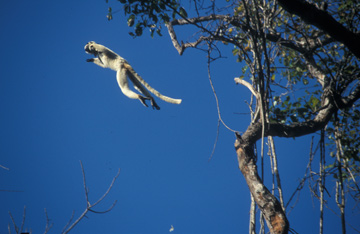 Sifakas are very agile lemurs, which can make far distance leaps between trees. Hunting them is hardly possible for a single fossa, but when several fossas unite to hunt cooperatively, sifakas don’t stand a chance. Photo © Melanie Dammhahn. |
Mia-Lana Lührs: This hunt was a very lucky occasion for me. My colleague and friend Dr. Melanie Dammhahn and I, we observed it mainly by coincidence. Three males had passed us in camp walking in single file. This attracted my attention because I had never seen three males peacefully together before. I was wondering whether they were an association, possibly littermates spending all their life together. Since they looked very target-oriented to me, I followed them at a distance. Shortly afterwards, I saw what they were targeting: a group of sifakas. They started hunting immediately, first by spatially separating one of the sifakas. The rest of the group fled and after a while even stopped emitting their typical alarm calls. What followed was probably the most impressive scene I have ever seen in my life (and probably for Melanie as well). The three male fossas started to hunt the single sifaka. At the beginning they were not very efficient. They jumped more or less randomly behind the sifaka which was not enough to catch such an agile lemur. The sifaka managed to escape them every so often just by jumping back and forth in the highest trees. One fossa even dropped to the ground during one of those trials which led to a little break in the hunt. After this break, the three fossas changed their strategy. They regularly alternated in their hunting roles. One fossa jumped behind the sifaka up in the tree, another ran in front on the ground and the third climbed trees in the direction of the sifaka’s course. After a few jumps, the fossa jumping behind the sifaka would come to the ground, another would take its part as the chaser and the third one would again climb trees to block the sifaka’s way. The whole chase went very quickly and at some point I was in the middle of it because the hunting fossas suddenly used the little wooden hut, which I used as a hide, as climbing substrate. Two males jumped right and left from me on the wooden beams of the hut, and splinters of wood, leaves and dust flew around me. Also, I could loudly hear them vocalizing, sounds of excitement, which appeared to be used for coordination of the hunting roles.
Forty-five minutes after the very start of this hunt, the three male fossas finally managed to catch the sifaka when it became tired and made a single wrong decision. They killed it out of sight but I could hear clearly how it ended. After they had killed the lemur, they shared its carcass sequentially, with the most dominant individual feeding first, then number two and finally the subordinate male eating the rest. By that time, I was sitting in another hut close to the place of the kill and was shivering all over after what I had seen. I can tell you that seeing fossas hunting, namely seeing fossas climbing so deftly and jumping so quickly and so incredibly far is one of the very beautiful scenes in nature where you can impressively see what fossas were made for: arboreal locomotion in perfection. The only moment where I was similarly excited was after I had seen a crocodile attacking a female fossa by the water-hole. In that case, however, the hunt was unsuccessful. Fortunately.
Mongabay: Why do you think the fossa—usually solitary—evolved cooperative hunting and sharing of food?
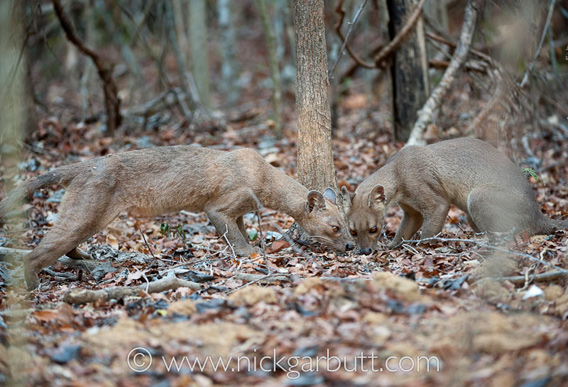
Two fossas. Photo © Nick Garbutt .
Mia-Lana Lührs: Cooperative hunting in fossas might be a phenomenon that is limited to associated individuals, i.e. mother and offspring during dependence or social males, presumably littermates. Truly solitary fossas, that is females and unrelated males, might not show this behavior. Unfortunately, hunts are so difficult to observe systematically that we cannot tell. Given the fossa’s life history, which includes long years of dependence when the offspring learns from its mother how to hunt, cooperative hunting might be optimized during this period and is then retained in social males only. When we consider the fact that only a few thousand years ago, Madagascar looked totally different and fossas inhabited a very different ecosystem with much larger prey species, namely giant lemurs, cooperative hunting may have been a means to take down prey much heavier than a single fossa’s body mass. Today, now that giant lemurs are extinct, cooperative hunting appears useless unless it allows the participating individuals to catch a sifaka more rapidly. In the case that I have seen, it took three males 45 minutes. All three of them were totally exhausted afterwards and had to share about three kilograms of meat by three. That does not appear to me as an effective strategy. This was why Melanie and I came up with the idea that Madagascar’s very recent past must explain such behavior.
THE THREATENED FOSSA
Mongabay: The fossa is currently listed as Vulnerable by the IUCN Red List. What threatens the species?
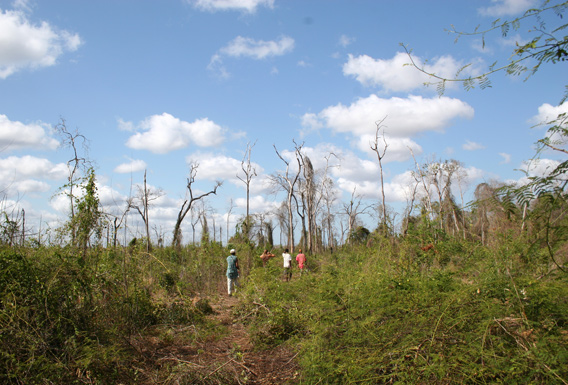
Forest in proximity to human settlements is often vastly degraded after fires, timber removal and introduction of nonnative plants. In these degraded areas biodiversity is reduced to insects and commensal species. Lemurs and fossas do not find suitable habitat here. Photo © Melanie Dammhahn.
Mia-Lana Lührs: Just like so many other animals listed by the IUCN Red List, the fossa is mostly threatened by habitat destruction. Fossas rely on intact forest because their prey species do so. Deforestation, however, is the biggest environmental problem Madagascar faces because slash-and-burn-agriculture is common and Malagasy people are among the poorest in the world. It is therefore very difficult to stop this trend of high deforestation rates. Since fossas as top predators have the highest spatial requirements of all species, they are usually the first to struggle once the forest areas become small. Locally, fossas are also threatened by typical human-carnivore conflict. When forests are small and food becomes sparse, fossas tend to invade villages to hunt fowl. Given the value of every single chicken for a poor villager, this conflict can result in killings of the respective fossas. Fortunately, hunting fossas for food seems to be a rather local phenomenon and does not impact all fossa populations in Madagascar. In Kirindy, we don’t face this problem yet. But mortality of fossas in surrounding village areas seems to be a major problem we will need to solve.
Frequent contact with humans also threatens fossas by transfer of illnesses, mostly from dogs. But this aspect has not yet been studied and might still be of minor importance compared to habitat loss.
Mongabay: Since villagers killing fossas is a major threat to the species, what are the solutions? Are the villagers directly to blame, or is there more going on?
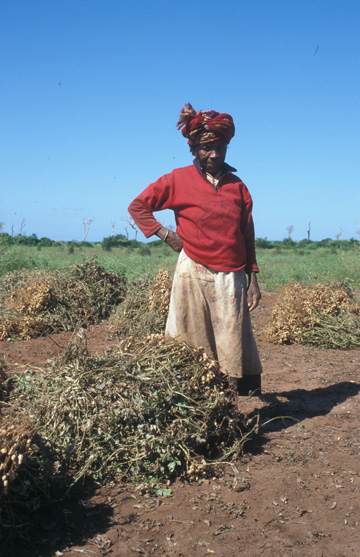 Madagascar is one of the poorest countries in the world. Subsistence farming often represents the only assurance of survival in rural areas. But the extreme seasonality of some regions in the west of Madagascar make farming difficult on exposed soils. Crops can grow only twice before the soil is depleted and washed away. Whereas in the first year corn can grow, in the second year only peanuts and manioc can be harvested. Photo © Melanie Dammhahn. |
Mia-Lana Lührs: Of course, we should not blame the people at all. The initial causes of the problem are habitat loss and poverty. When the forest surface becomes too small, fossas become packed and the animals struggle to find enough food or to establish a territory, they push more and more out of the forest into the deforested matrix. If in the villages they find easy-to-catch food (i.e. domestic fowl), they just do what their nature tells them. From the villagers perspective again, the value of a single chicken (given the poverty in Madagascar) is so high that the thief needs to be punished or even extirpated to prevent such events in the future. Both parties are therefore right, you see. The villager just wants to save the chicken as food for his/her children while the fossa is hungry and desperate.
One idea we came up with for a conservation project was to build chicken cages in the villages, but we will need to test it first. I hope that by building fossa-proof cages we can achieve two major goals: (1) protect the villagers’ food, i.e. fowl, and (2) make fossas learn that there is nothing to get in villages. This will hopefully lead to less frequent fossa visits in the villages. It does, of course, not solve the initial problem that fossas simply do not have enough space. But stopping the killing would save the remaining fossas, which might by now be so few that the space issue will only arise as a problem for next fossa generation (if the population manages to reproduce).
On the longer perspective, I see an urgent need to make local people benefit from conservation: possibly the only way to change their mind about how to deal with fossas would be to assign some economic value to a living fossa. Until now villagers do not see any economic value in a fossa, they just perceive it as a pest. But in fact, many tourists come every year to Kirindy to see exactly this species. Their money, however, rarely ends up in the villages. What we need is the awareness that the forest and its biodiversity are property of Malagasy people and that we should pay money for them to protect this forest and this species thereby creating some alternative income. And we are talking about very little money from our perspective which could make big changes from a Malagasy perspective.
Mongabay: What has your observations in Kirindy told you about how fossas are faring in face of deforestation and increasingly less habitat? How is lack of habitat affecting fossa behavior?
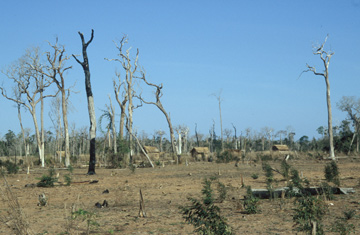 A single small village with only a few huts can “consume” unimaginable areas of forest by burning concentrically from the village core. What remains is dead soil and dust. The poorest people in Madagascar cannot even afford a single tree for shade. Photo © Melanie Dammhahn. |
Mia-Lana Lührs: We can’t tell for sure how the loss of habitat affects the fossas’ behavior because we have no “natural” case to compare to. In fact, every single forest fragment in Madagascar is likely too small to reflect the fossa’s natural ranging behavior. It is more likely that the remaining populations are over-crowded and that dispersal is limited or impossible. We can therefore only guess what the impact of habitat loss might be.
In Kirindy Forest, for example, it is obvious that the population is packed. The local density is probably the highest possible, i.e. the remaining habitat is oversaturated. Females likely have smaller territories than would naturally be the case because they have to share little space with all the other females. An indication of this we got from a case where one female abandoned its territory because of a severe injury. As a result, a neighboring female expanded its territory into the former of the other female. It thereby achieved a territory of double surface. When a female is born in Kirindy, it has no space to go in order to establish its own territory. We have some indication that in these cases females stay in their mother’s territory but avoid their mothers temporally. This results in two solitary females sharing exactly the same forest area.
In females, the space limitation of their territories is likely to result in higher infant mortality since the surface of a female’s territory is normally determined by the availability of food resources. If the female cannot hold a territory big enough to feed its offspring, infant mortality is likely high due to starvation, especially during the dry season when food is very limited.
In males, habitat loss seems to cause different problems compared to females. Given that limited space results in a limited number of females, males might gain access to less females in Kirindy than would naturally be the case. The number of mating trees in Kirindy is clearly limited. Even if a male covers the whole remaining surface of Kirindy, it will likely include, let’s say, eight mating trees in its range and thereby possibly less than naturally.
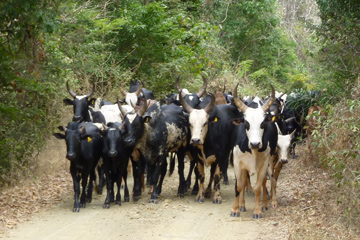 The zebu, Malagasy cattle, as an important feature of Malagasy culture poses another serious threat to Madagascar’s biodiversity. In order to support their big zebu herds with fresh grass, farmers burn down forested areas to turn them into savannah. Photo © Melanie Dammhahn. |
What is also obvious when looking at ranging data is the intense overlap of male ranges in the core of the fragment, which likely results in frequent encounters of overlapping males. In natural situations, males would try to avoid each other temporally in these overlap areas. But in Kirindy, the number of males sharing the same core areas is so high that they statistically must run into each other every so often. This will in most cases result in a short chase, in other situations, though, it might end lethally when the inferior competitor doesn’t manage to escape. This is a likely scenario given the dominance of heavy associated males over small solitary males. When it comes to dispersal, i.e. when young males search for areas where male density is lower in order to establish a range, they are likely to end up in deforested matrix surrounding Kirindy and thereby in human settlements. Given the habitat loss in Kirindy, young males likely have to choose between frequent fights with other fossas of the same sex or fights with dogs or villagers beyond the edge of the forest.
In addition to these impacts on the fossa’s ranging behavior, we also observe some other behavioral changes in Kirindy Forest as a result of anthropogenic disturbance. One such change is a habituation effect which is achieved by frequent encounters with humans. Given the large ranges of males, every single male will have contact with humans either at the edge of the forest or in the centre (a tourist camp) or both. In the tourist site, for example, fossas get used to human presence and learn that humans do not represent any threat. In fact, they leave a lot of food resources as litter and support water all year round. Fossas overlapping with this site get habituated to humans and might even reduce their range sizes because of the predictability of litter as a food source as compared to natural food sources. By contrast, fossas living at the edge of the forest frequently encounter humans as well but (if they survive) learn that humans represent danger. Given the intense human anthropogenic pressure from the edge, fossas seem to concentrate more and more in the centre of the forest and thus around the tourist site. This results in two important threats. First, fossas which get habituated to humans in the tourist site, will easily invade villages surrounding the forest thereby representing a threat to fowl and even people. They will also be vulnerable to being killed by villagers. Second, more and more fossas will escape the harsh conditions in a packed population by invading the tourist site. We have seen very healthy and strong males refusing to hunt for food as long as they are provided with easy-to-get meals from litter. They spend most of their time defending a small territory surrounding the campsite, which predictably delivers food and water. As a result, they not only reduce their natural behavior but they are also exposed to threats such as illnesses and injuries from what they feed on (rice and beans in the best case, car oil, rat poison and sharp tins in the worst). Moreover, they behave unnaturally towards humans, lose all their fear and thereby become a threat. These are all very serious problems we are currently facing and trying to solve in Kirindy Forest.
Mongabay: How hopeful are you for the future of fossas?
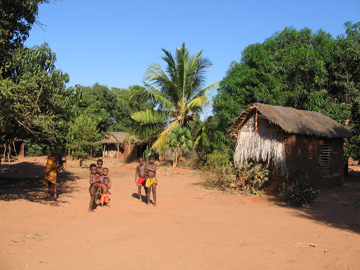 Madagascar is young. More than 40% of its inhabitants are less than 14 years old. Especially in rural areas children are important helpers for the harvest. But mortality is high for Malagasy children; they are often malnourished (as are their parents) and education is expensive and time-consuming. This background makes conservation a serious human development issue in the country. Photo © Melanie Dammhahn. |
Mia-Lana Lührs: Well, given the problems of ongoing habitat destruction, conflict with people, its lack of popularity as well as the political situation in Madagascar, I am accordingly pessimistic concerning the fossas’ future. Yet, I am not hopeless. Although we will always remain powerless concerning the politics, I believe we can influence all other threats. I still believe that we can protect the forests, that there are ways to deal with the human-carnivore conflict which both parties can benefit from, and that making the fossa more popular is an easy thing once we found the right platform for it.
In collaboration with Duisburg Zoo, we are currently trying to combine exactly those three points in a fossa conservation project for Kirindy Forest.
Mongabay: What conservation recommendations would you make to ensure the fossa’s survival?
Mia-Lana Lührs: First, I would urgently recommend an intensive fossa survey all over Madagascar in order to reliably determine how many fossas are left and in which areas populations are struggling to survive and might therefore need conservation strategies. Because I see the biggest problems for fossas in general data deficiency (we simply don’t know anything) and their generally bad reputation. Without knowing what is going on in the fragments we can’t tell anything about the distribution of the species on this island. It makes me very concerned that in many books about Madagascar wildlife, the distribution of the fossa is described as “all over the island”. In fact, Madagascar’s remaining forest areas are fragmented and these fragments are often of small surface, which is unlikely to sustain a viable fossa population. So finding some feces in a forest is not enough, since this might be feces of one single individual remaining. I therefore recommend an inventory using camera-traps or fecal sampling with subsequent genotyping in all the forest fragments which presumably contain fossas. Based on appropriate population estimates one could develop respective conservation strategies if necessary. Those must again be adapted to each individual case.
In the case of Kirindy Forest, for example, the most proximate step must be to stop the killing of fossas by humans in order to conserve the population as it is now (i.e. the maximum number of individuals left). As a next step, we would need to determine exactly how many individuals of each sex are left and how closely related those are. If they turn out to be highly inbred, it might be necessary to translocate individuals. Once these actions are implemented, it will be necessary to monitor all the critical populations continuously in order to keep track of population size and density, sex ratio, mortality and the level of inbreeding.
Mongabay: Any future plans you would like to share with us?
Mia-Lana Lührs: Well, I’m hoping to go on with research on fossas, of course, but this depend on whether I will manage to find a position after my PhD and on which project. In any case, I would like to continue studies on carnivores, and ideally, the little known ones:-)
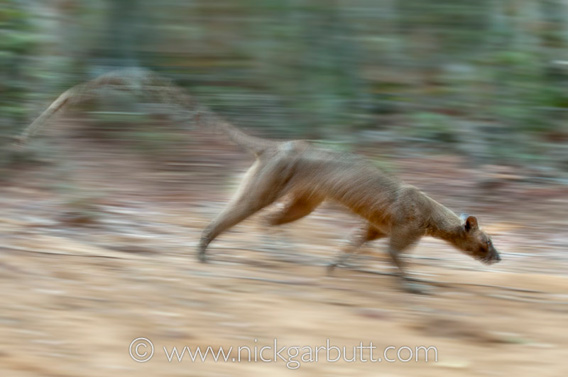
Fossa on the run. Photo © Nick Garbutt .
Related articles
Picture: unknown carnivore discovered in Madagascar lake
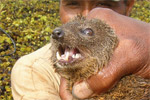
(10/10/2010) Researchers have identified a previously unknown species of carnivore lurking in one of the world’s most endangered lakes. Durrell’s vontsira (Salanoia durrelli), named in honor of the late conservationist and writer Gerald Durrell, was first photographed swimming in Madagascar’s Lake Alaotra in 2004. Subsequent surveys by scientists at the the Durrell Wildlife Conservation Trust, the Natural History Museum, London, Nature Heritage, Jersey, and Conservation International confirmed the mongoose-like creature was indeed a new species.
Extensive logging, lemur hunting in Madagascar national park despite moratorium

(11/16/2010) A biological survey in Northeastern Madagascar has turned up evidence of extensive logging in Masoala National Park, a UNESCO World Heritage Site renowned for its biologically-rich rainforest. The findings suggest that harvesting of valuable hardwoods—including rosewood, ebony, and palissander—continues despite an official ban on the logging and export of timber.
The $1M bed: why Madagascar’s rainforests are being destroyed
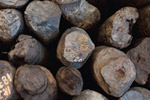 (10/26/2010) Consumer demand for rosewood furniture and musical instruments is driving illegal logging in Madagascar’s national parks, endangering wildlife and undermining local community livelihoods, according to a new report from the Environmental Investigation Agency (EIA) and Global Witness. The report, based on more than a year of investigations, shows that Madagascar’s valuable hardwoods—including ebony, pallisander, and rosewood—are being illegally harvested from rainforest parks and trafficked to Asia, Europe, and the United States. The vast majority of timber however ends up in China, where it is converted into luxury furniture.
(10/26/2010) Consumer demand for rosewood furniture and musical instruments is driving illegal logging in Madagascar’s national parks, endangering wildlife and undermining local community livelihoods, according to a new report from the Environmental Investigation Agency (EIA) and Global Witness. The report, based on more than a year of investigations, shows that Madagascar’s valuable hardwoods—including ebony, pallisander, and rosewood—are being illegally harvested from rainforest parks and trafficked to Asia, Europe, and the United States. The vast majority of timber however ends up in China, where it is converted into luxury furniture.
Video: Madagascar could become “Haiti-like”
(04/28/2010) Niall O’Connor from the World Wildlife Fund warns in a Carte Blanche production that if the ecological destruction of Madagascar continues, the poor island country could become “Haiti-like”, where he says, “most of the biodiversity, most of the forests are gone”.
Humans push half of the world’s primates toward extinction, lemurs in particular trouble
(02/18/2010) Of the known 634 primate species in the world 48 percent are currently threatened with extinction, making mankind’s closes relatives one of the most endangered animal groups in the world. In order to bring awareness to the desperate state of primates, a new report by the International Union for the Conservation of Nature highlights twenty-five primates in the most need of rapid conservation action. Compiled by 85 experts the report, entitled Primates in Peril: The World’s 25 Most Endangered Primates, 2008–2010, includes six primates from Africa, eleven from Asia, three from Central and South America, and five from the island of Madagascar.
How to end Madagascar’s logging crisis
 (02/10/2010) In the aftermath of a military coup last March, Madagascar’s rainforests have been pillaged for precious hardwoods, including rosewood and ebonies. Tens of thousands of hectares have been affected, including some of the island’s most biologically-diverse national parks: Marojejy, Masoala, and Makira. Illegal logging has also spurred the rise of a commercial bushmeat trade. Hunters are now slaughtering rare and gentle lemurs for restaurants.
(02/10/2010) In the aftermath of a military coup last March, Madagascar’s rainforests have been pillaged for precious hardwoods, including rosewood and ebonies. Tens of thousands of hectares have been affected, including some of the island’s most biologically-diverse national parks: Marojejy, Masoala, and Makira. Illegal logging has also spurred the rise of a commercial bushmeat trade. Hunters are now slaughtering rare and gentle lemurs for restaurants.
Lessons from the crisis in Madagascar, an interview with Erik Patel
 (08/11/2009) On March 17th of this year the President of Madagascar, Marc Ravalomanana, resigned his post. This made way for Andry Rajoelina, mayor of Madagascar’s capital, to install himself as president with help from the military. The unrest and confusion that usually accompanies such a coup brought disaster on many of Madagascar’s biological treasures. Within days of Ravalomanana’s resignation, armed gangs, allegedly funded by Chinese traders, entered two of Madagascar’s world-renowned national parks, Marojejy and Masoala parks, and began to log rosewood, ebonies, and other valuable hardwoods. The pillaging lasted months but the situation began to calm down over the summer. Now that the crisis in Madagascar has abated—at least for the time being—it’s time to take stock. In order to do so, Mongabay spoke to Erik Patel, an expert on the Critically Endangered Silky Sifaka and frequent visitor to Madagascar, to find out what the damage looks like firsthand and to see what lessons might be learned.
(08/11/2009) On March 17th of this year the President of Madagascar, Marc Ravalomanana, resigned his post. This made way for Andry Rajoelina, mayor of Madagascar’s capital, to install himself as president with help from the military. The unrest and confusion that usually accompanies such a coup brought disaster on many of Madagascar’s biological treasures. Within days of Ravalomanana’s resignation, armed gangs, allegedly funded by Chinese traders, entered two of Madagascar’s world-renowned national parks, Marojejy and Masoala parks, and began to log rosewood, ebonies, and other valuable hardwoods. The pillaging lasted months but the situation began to calm down over the summer. Now that the crisis in Madagascar has abated—at least for the time being—it’s time to take stock. In order to do so, Mongabay spoke to Erik Patel, an expert on the Critically Endangered Silky Sifaka and frequent visitor to Madagascar, to find out what the damage looks like firsthand and to see what lessons might be learned.
Political turmoil in Madagascar threatens lemurs, parks
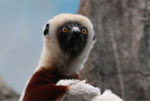
(03/19/2009) Political turmoil in Madagascar has wrecked the country’s emerging ecotourism industry and is now threatening to undo decades of conservation work. Conservation in Madagascar is highly dependent on income from tourism. Half of park entrance fees are returned to communities living in and around protected areas. Without this source of income, locals in some areas may turn to conservation areas for timber, fuelwood, agricultural land, and wildlife as food and for export.
In search of wildlife, while dodging leeches, in Madagascar’s unexplored rainforest
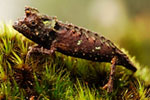 (02/05/2007) It is called a rainforest for a reason–because it rains…. and rains. As my field partner, Angelin Razafimanantsoa, and I make our way down muddy mountainsides in the endless downpour, we stop only long enough to pick squirming, bloodthirsty leeches off each other’s face. Hours pass as we wade through knee-deep streams rushing over smooth, slippery rocks and thick forest stands. Seven hours ago, we anticipated arriving at our next base camp in three hours’ time. Now, as night is falling, it seems we have at least five hours more to go.
(02/05/2007) It is called a rainforest for a reason–because it rains…. and rains. As my field partner, Angelin Razafimanantsoa, and I make our way down muddy mountainsides in the endless downpour, we stop only long enough to pick squirming, bloodthirsty leeches off each other’s face. Hours pass as we wade through knee-deep streams rushing over smooth, slippery rocks and thick forest stands. Seven hours ago, we anticipated arriving at our next base camp in three hours’ time. Now, as night is falling, it seems we have at least five hours more to go.
